11 best coffee concentrates, tested and reviewed
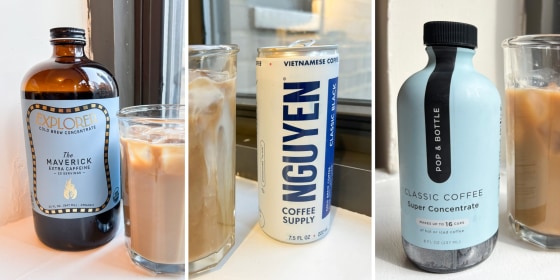

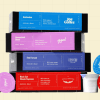
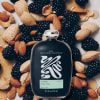
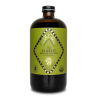
When selecting the best coffee concentrates to test, I considered the following expert-recommended factors:
Our NBC Select editors tested coffee concentrates across different brands, price points, caffeine levels and flavors. During the two-month testing period, we considered the below factors and shared feedback to determine the quality and ease of use for each concentrate.
Below, I compiled the best coffee and cold brew concentrates tested by our NBC Select editors.
Jot earned the top spot among our testers because it tastes great, it’s easy to prepare and comes in multiple flavors, including seasonal ones. “Jot is definitely the smoothest coffee concentrate I’ve tried, and it has a rich, warm flavor, which is exactly what I look for in a good cup of joe,” says NBC reporter Zoe Malin. “There really aren’t any acidic or bright notes. It’s more chocolatey, so I only add a little milk before I drink it.”
Though Malin isn’t usually a flavored coffee person, she loves Jot’s vanilla flavor and actually gravitates toward it more than the original flavor, which she can’t say about many other brands. “The vanilla flavor adds a hint of sweetness to the coffee without tasting sugary or artificial, and it pairs so nicely with a splash of oat milk. I find it super refreshing, especially as an afternoon pick-me-up,” says Malin.
Cups per bottle: 14 | Dilution ratio (ounces): 0.5 part concentrate to 8 parts water
Cometeer’s coffee pods are one of our editors’ favorite options; in fact, this was the one I enjoyed the most out of all the concentrates I tested. I tried out the Mixed Roast Box, which comes with a range of light, medium and dark varieties from different roasters across the country. Each shipment (which you’ll need to store in the freezer) includes coffees with different flavor profiles and roasts, which lets me expand my coffee tastes and compare my favorites. Plus, they’re super versatile: I can make iced coffee, lattes and hot coffee using these pods. If you typically stick to one coffee type, you can also choose to receive boxes of only light, medium, dark or decaf roasts. You can choose to receive a pack of four (32 capsules) or eight (48 capsules).
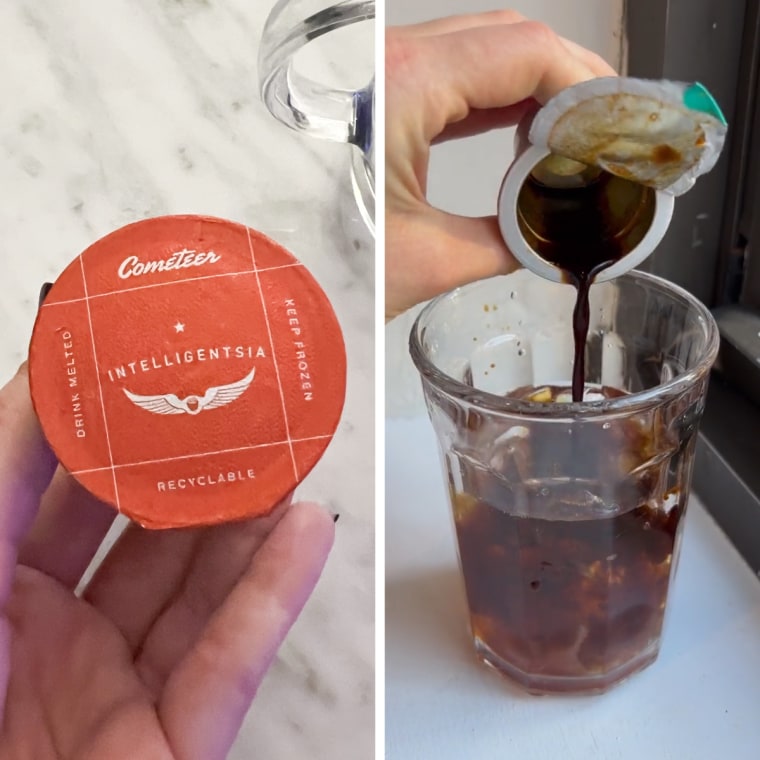
Cometeer freezes the coffee at peak flavor, which helps preserve its taste for months. That’s not marketing — it’s fully true, says Malin. “I don’t make coffee at home every day, so once I open a bottle of concentrate, it can be about two weeks until I drink the whole thing. At the end of those two weeks, the flavor definitely declines in intensity,” she says. “But since Cometeer’s pods have a three-year shelf life in the freezer, I don’t have to worry about decreasing intensity. Whether I make coffee with the pods the day I get my box in the mail or five months later, I get the same exact flavor.”
Cups per pack: 32 | Dilution ratio: 1 pod to 8 parts liquid
This concentrate is definitely on the pricey side, but it’s well worth it, according to our testers. “Each of the flavors I tried were more sophisticated than the concentrates you’d typically find in the grocery store — they’re a bit stronger and more intense, and the tasting notes are more pronounced,” says Malin. The brand has detailed information online about tasting notes, the bean’s origins and cupping score, which makes it best for the expert or experienced coffee drinker. “It does require a level of coffee knowledge I don’t think the average person who simply likes coffee has. That said, if you’re someone who likes a super flavorful and more intense cup of coffee, this would be ideal for you,” says Malin.
Kloo’s concentrate bottles are the most aesthetically pleasing, eye-catching ones we saw during our testing — they look similar to bottles you’d see packaging a fancy liquor or spirit. The bottle looks great on a mantle or coffee bar, and it makes a great gift. Plus, the set comes with a coffee tasting wheel and accessories like a jigger (which perfectly measures out the recommended amount of concentrate), and it’s all neatly packed inside a drawstring bag. You can choose to receive two, three or four bottles, and you can mix-and-match origins, which include Colombia, Kenya, Ethiopia and Guatemala.
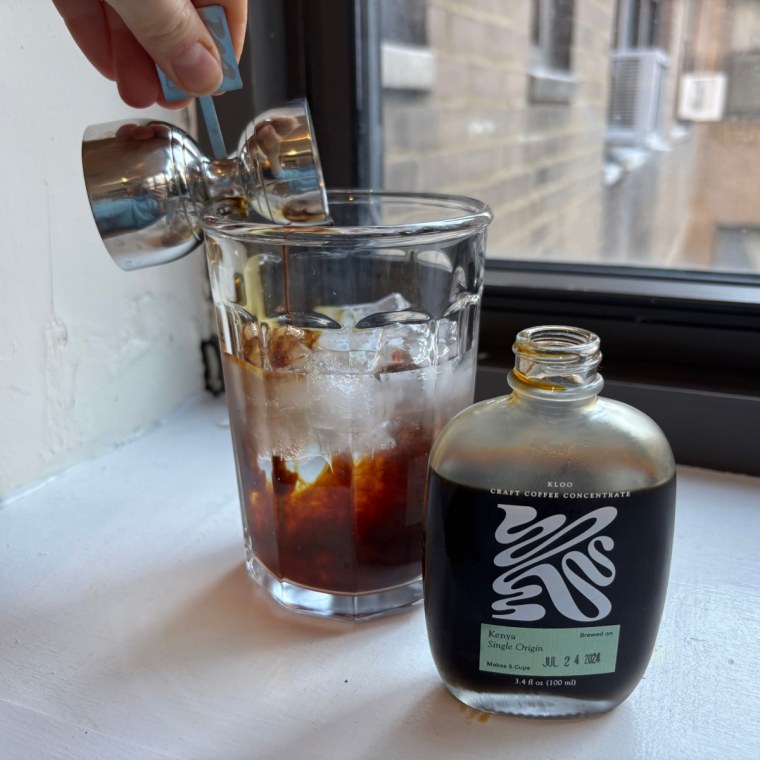
Cups per bottle: 12 | Dilution rate: 0.75 parts concentrate to 7 parts water
Explorer Cold Brew’s concentrates come in four caffeine options — standard, high, half caffeine and decaf — which makes it a great option for those who want to drink cold brew while still closely monitoring their caffeine consumption. Our editors tried all of these varieties, and they were very well-received. I tested the standard caffeine option, which has a smooth, robust flavor and works great for making lattes and iced coffee. NBC Select editor Jordan Bowman tried the low caffeine option, and though he doesn’t typically drink decaf, he actually preferred the smoother taste of this concentrate. “It was a pleasant drinking experience overall. The concentrate is easy to prepare — add water, cream, sugar and you’re good to go,” he says. (However, Bowman found the bottle to be on the larger side, which was a bit awkward to pour.)
Malin, who tried the extra caffeine version, enjoyed the strength and flavor, which she found to be a bit more acidic compared to other options she tried. “The flavor is noticeable but not overwhelming. I’m not super sensitive to caffeine because I drink coffee so often and have for years, so I didn’t notice a difference in how I felt with the high caffeine coffee versus the standard caffeine option,” says Malin.
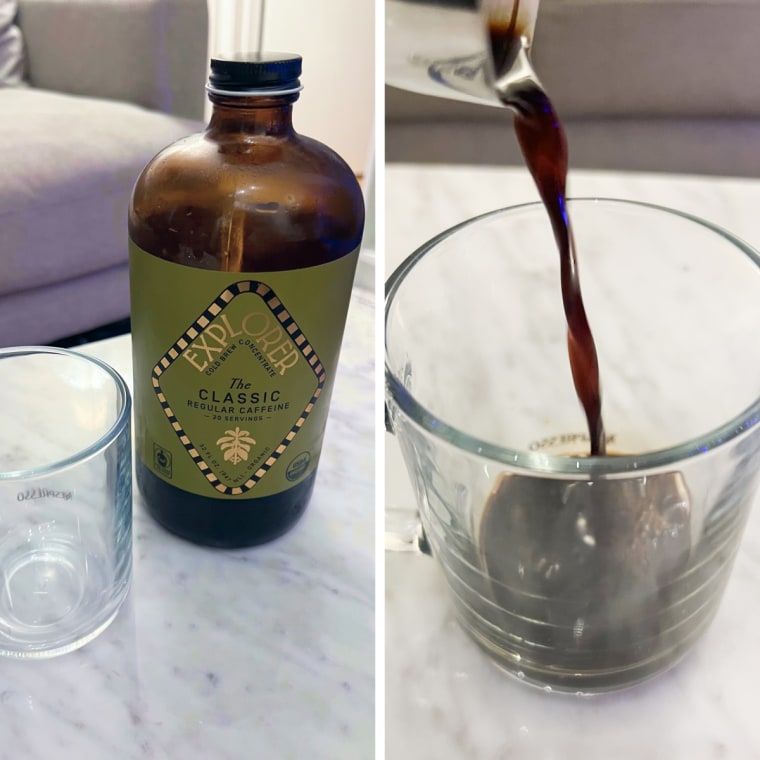
Cups per bottle: 20 | Dilution ratio: 1 part concentrate to 4 parts liquid
If you’re looking to make coffee concentrate at home (and don’t mind the more involved, time-consuming process), these cold brew pouches are the way to go. The process itself isn’t bad: I simply place a single pouch inside a large jug, fill it up with 24 ounces of water, stir it and let it steep in my fridge for 24 hours. Though I typically prefer the convenience of pre-packaged coffee concentrate, I ultimately love the rich chocolate and caramel flavor of this cold brew. Since I steep it for a long period of time, I also find it tastes much stronger than other pre-packaged options I’ve tried, and as a strong coffee lover, I’m a big fan.
Cups per pouch: 14 | Dilution ratio: 1 pouch to 1 part water
Java House’s cold brew concentrate is definitely on the strong side — several of our editors noted they picked this up when they needed a caffeine boost. However, despite the intensity, it still tasted great: It has a strong, rich flavor that our testers could still taste after mixing it with cream or milk, plus it didn’t have that bitter aftertaste that many coffee concentrates do. However, it is a little less versatile than other options: it’s best served cold and there aren’t many other flavors to choose from besides the original blend.
In addition to the 32-ounce cold brew concentrate bottle, Java House also offers boxed cold brew and cold brew pods, which come in multiple flavors and decaf.
Cups per bottle: 20 | Dilution ratio: 1 part concentrate to 4 parts water
Compared to other coffee concentrates on this list, this Pop & Bottle option has a lighter flavor, which isn’t necessarily a bad thing — if you’re someone who doesn’t love the taste or intensity of coffee, this is a great option for you, according to our testers. It comes in several flavors, including vanilla, caramel and mocha, as well as a variety pack of three that lets you try different roasts. It’s also a great price: At around $17 per bottle (which makes 16 cups), it’s more affordable than several other options on this list.

Cups per bottle: 16 | Dilution ratio: 0.5 parts concentrate to 6 parts water
NBC Select video producer Josh Rios has been drinking Grady’s coffee concentrate for the last five years and it’s one of his favorite ways to prepare cold brew. “I use the concentrate to make myself a single cup of coffee when I’m a little impatient,” he says. “The glass bottle sits perfectly in my fridge for when I’m ready to pour it into a half a cup of regular water. With just a little dash of concentrate, it makes a strong cup of cold brew in a short amount of time.” It has a rich, nutty flavor with hints of chicory and chocolate, though Rios gravitates more toward Grady’s Cold Brew Vanilla Concentrate. “Like with most concentrates, you have to cut the potency with water or you’re going to be vibrating through walls,” says Rios. You can also get this concentrate in pouches to help you easily take it with you on the go.
You can purchase a 6-pack or 12-pack of Grady’s cold brew concentrate on the brand’s website.
Cups per bottle: 8 | Dilution ratio: n/a
“I really love this coffee concentrate — it’s flavorful but not too in your face, so it’s easy to drink and very smooth. There’s really no frills to it and it’s reliably good every time I drink it, making it ideal to keep in my fridge all the time,” says Malin. In addition to the smooth, rich taste, the concentrate is the easiest to prepare out of all the ones our editors tried: It’s a 1:1 ratio of concentrate to water (or any liquid of your choice), so you can easily measure it out or even eyeball it (plus, it’s easy enough to remember where you don’t have to keep referencing that ratio every time you make your coffee). The concentrate comes in several delicious flavors, including hazelnut, pumpkin spiced pie, cinnamon vanilla and mocha (the brand’s ready-to-drink cold brew lattes also come in Girl Scout Cookies flavors). Our editors noted that while the concentrate’s glass bottle looks sleek and attractive, it does require a bit more attention if you’re accident-prone.
Total cups: 8 | Dilution ratio: 1 part concentrate to 1 part liquid
If you’re looking for a decaf option that still tastes like a good cup of coffee, consider this one from Java House. NBC Select SEO editor Nikki Brown, who doesn’t typically drink coffee every day, enjoyed the flavor of this concentrate. “It’s smooth with a hint of chocolate and walnut (though not getting any of the fruitiness). It’s decaf so the strength is low but it’s been a nice afternoon pick-me-up,” she says. Reviewers say it doesn’t have the bitterness of most fully-caffeinated coffee concentrates. Brown also found it easy to prepare: The dilution instructions are on the side of the bottle and simple to follow. Keep in mind since this is a decaf option, the dilution ratio is to adjust the taste rather than the caffeine levels, so you can drink it without diluting if you want.
Cups per bottle: 20 | Dilution ratio: 1 part concentrate to 4 parts liquid
Though not quite a concentrate, these Nguyen Coffee Supply coffees were our editors’ favorite ready-to-drink cold brews. Malin, who refrigerated the cans, poured the cold brew over ice and added oat milk to make iced coffee. “I was honestly surprised by how good this was. I think I was a little thrown by the fact that it came in a can, and I weirdly expected it to be slightly bubbly, but it wasn’t at all. It was just smooth, flavorful coffee,” says Malin. I was also a big fan of these cans: They’re easy to take on the go, so I often drank them in the office or on the way to work. Our reviewers say the coffee has a rich, chocolate flavor, and the 7.5-ounce cans are an ideal serving size. “Each can is about $4 when you work it out, which is less that I’d pay at a coffee shop,” says Malin.
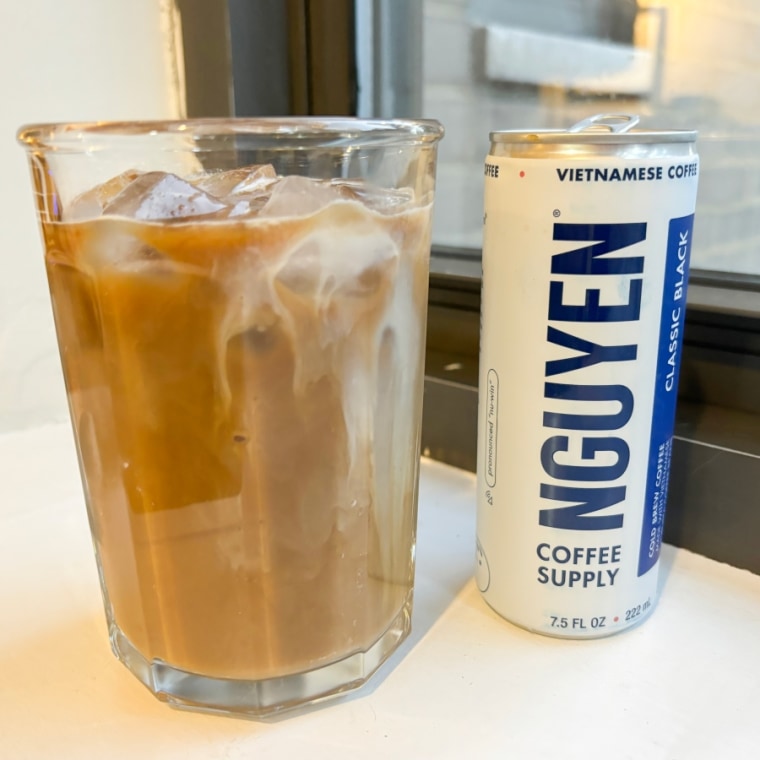
Cups per pack: 3.75 (4-pack), 11.25 (12-pack) | Dilution ratio: n/a
A coffee concentrate is a strong coffee liquid made by steeping coarse beans or grounds in cold water for a long period of time (usually 24 hours or longer). You’ll need to dilute before it’s ready to drink. “Concentrates are typically more convenient than brewing a fresh coffee beverage because all the roasted coffee grinding, measuring and brewing was already completed for you,” says Spencer Turer, vice president of Coffee Enterprises, a coffee testing laboratory and consultancy in Hinesburg, Vermont.
“There is a preferred ratio of coffee to water when brewing coffee that makes a pleasant and balanced cup. The golden ratio is around 1 part coffee to 17 parts water. Coffee concentrate increases that ratio so there’s more coffee to water, usually around one part coffee to 10 parts water,” says Marco Suarez, co-owner of Methodical Coffee.
You can dilute the concentrate with hot or cold water, or with hot or cold milk. You can also use coffee concentrates as a flavor component to smoothies, cocktails and as an ingredient in recipes — you’ll get the strong coffee flavor without needing to add a lot of liquid, says Turer. For example, Suarez uses coffee concentrate when making tiramisu, adds it to his morning protein smoothie or pours a little over vanilla ice cream.
Coffee concentrates tend to have much more caffeine than your typical drip coffee, which is simply due to using more coffee in the brewing process. Concentrate is coffee that is brewed with a strong coffee to water ratio — since there is typically more coffee (and less water) used to make concentrate and the coffee is steeped for longer (typically 6-24 hours), it’s ultimately stronger, says Suarez. However, it’s difficult to tell exactly the difference between caffeine levels because coffee is an agricultural product, and there’s several varieties of coffee plants that produce different amounts of caffeine, says Suarez.
Keep in mind that when researching caffeine in coffee concentrates, it’s important to look at the amount of caffeine in milligrams per fluid ounce in the concentrate, which is listed on the packaging, says Turer. This tells you exactly how much caffeine is in your concentrate based on the serving size and prevents a guessing game when you’re preparing your cup.
There are a few things to keep in mind when shopping for a coffee or cold brew concentrate, specifically flavor and preparation method.
Most coffee and cold brew concentrates are ready to prepare from the bottle — each one has a specific dilution ratio based on concentration level. Some concentrates have a 1:1 ratio for dilution, while others have greater concentration of flavor and less liquid, which means you’ll need to dilute it more to achieve the desired strength, says Turer. Coffee concentrates are easily mixed in a glass with milk or water, either hot or cold.
Coffee concentrates are notably very caffeinated (more than your typical drip coffee or ready-to-drink lattes), which goes hand-in-hand with dilution ratio. The best part is, you can adjust the caffeine level based on your personal preferences — simply dilute it with more or less liquid, depending on how strong or weak you want it. If you’re sensitive to caffeine, several brands also have decaf options, which means dilution mostly affects flavor rather than caffeine levels.
How strong you prepare your concentrate will inevitably affect the flavor. While you can add syrups to change up the taste, many brands also offer flavored coffee concentrates, including vanilla, mocha or caramel.
Coffee concentrates don’t just come in bottles and cans — you’ll find options in pods, powders and steeping pouches. The packaging you choose depends on several factors, including how easy the concentrate is to store and take on the go (smaller pouches, for example, are handy when you’re traveling), whether it affects preparation (a larger bottle might be harder to pour and measure) and the overall aesthetic to match your personal style and decor.
At NBC Select, we work with experts who have specialized knowledge and authority based on relevant training and/or experience. We also take steps to ensure all expert advice and recommendations are made independently and without undisclosed financial conflicts of interest.
I’m an updates editor at NBC Select with four years of experience writing about coffee and coffee makers. For this article, I spoke to three coffee experts about what to consider when shopping for a coffee concentrate and how to best prepare it. I and three other NBC Select editors also tested more than a dozen cold brew concentrates to find the best ones based on strength, flavor, packaging and preparation method.
Catch up on NBC Select’s in-depth coverage of personal finance, tech and tools, wellness and more, and follow us on Facebook, Instagram, Twitter and TikTok to stay up to date.